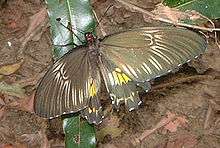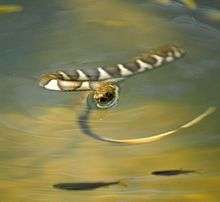Sinharaja Forest Reserve
Sinharaja Forest Reserve is a forest reserve and a biodiversity hotspot in Sri Lanka. It is of international significance and has been designated a Biosphere Reserve and World Heritage Site by UNESCO.
| Sinharaja Forest Reserve | |
|---|---|
.jpg) | |
| Location | Sabaragamuwa and Southern Provinces, Sri Lanka |
| Coordinates | 6°25′00″N 80°30′00″E |
| Area | 88.64 km2 (34.22 sq mi) |
| Established | April, 1978 |
| Governing body | Department of Forest Conservation |
| Criteria | Natural: ix, x |
| Reference | 405 |
| Inscription | 1988 (12th session) |
According to International Union for Conservation of Nature (IUCN), Sinharaja is the country's last viable area of primary tropical rainforest. More than 60% of the trees are endemic and many of them are considered rare.
The hilly virgin rainforest, part of the Sri Lanka lowland rain forests ecoregion, was saved from the worst of commercial logging by its inaccessibility, and was designated a World Biosphere Reserve in 1978 and a World Heritage Site in 1988. The reserve's name translates as Lion Kingdom.
The reserve is only 21 km (13 mi) from east to west, and a maximum of 7 km (4.3 mi) from north to south, but it is a treasure trove of endemic species, including trees, insects, amphibians, reptiles, birds, and mammals.
Because of the dense vegetation, wildlife is not as easily seen as at dry-zone national parks such as Yala. There are about 3 elephants, and 15 or so leopards. The most common larger mammal is the endemic purple-faced langur.
Birds tend to move in mixed feeding flocks, invariably led by the fearless Sri Lanka Crested Drongo and the noisy orange-billed babbler. Of Sri Lanka's 26 endemic birds, the 20 rainforest species all occur here, including the elusive red-faced malkoha, green-billed coucal and Sri Lanka blue magpie.
Reptiles include the endemic green pit viper and hump-nosed vipers, and there are a large variety of amphibians, especially tree frogs. Invertebrates include the endemic common birdwing butterfly and leeches.
Social Integration
The reserve is well-integrated with the local population that are living in some dozens of villages dotted along the border. The villages are more in number along the southern border whilst the presence of some large estates along the northern border has resulted in only a few villages there. The locals collect herbal medicine, edible fruits, nuts, mushrooms, other non-timber forest products including bees honey and a sugary sap collected from a local palm species of the genus Caryota. The sap is converted into jaggery, a local brew and vinegar. Local people walk in the forest to collect above items when they are not busy with their other agricultural pursuits. In addition, the crystal-clear water coming from dozens of streams is the main water source for all people living around the reserve. For generations, local people trekked through the forest from south to north to make their annual pilgrimage to the Adams Peak.
Gallery
 A waterfall in Sinharaja Rainforest
A waterfall in Sinharaja Rainforest Common Birdwing
Common Birdwing Yellow-browed bulbul
Yellow-browed bulbul Purple-faced langur with baby
Purple-faced langur with baby A stream in the reserve
A stream in the reserve- The high tree canopy in the reserve
 Xenochrophis asperrimus
Xenochrophis asperrimus